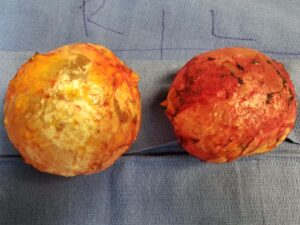You might have heard or come across the term “capsulectomy” as relates to breast implants. Maybe you saw it online, heard it from a friend who has implant related issues or even heard it from a physician who has recommended the procedure either for you or to a friend.
So what exactly is a capsulectomy and how does it relate to breast implants?
What is a Capsulectomy?
When a breast implant is placed in one’s body, the immune system triggers a response resulting in scar tissue forming around it. This scar tissue is called a capsule. Interestingly, this same response also occurs with other objects that enter our body one way or another – like splinters, pacemakers and shunts. However, in these cases, the capsule has no clinical relevance such as relates to function or appearance.
When there are medical indications for the removal of this capsule, the procedure which accomplishes this is known as a capsulectomy. There are a few different types of capsulectomies.
Types of Capsulectomies
Capsulectomies are performed in response to a medical need or indication for the removal of the capsule. There are three different types of capsulectomies that can be specifically selected and performed based on the clinical situation. These include a partial capsulectomy, total capsulectomy and an en bloc capsulectomy.
Partial Capsulectomy
A partial capsulectomy is where some of the capsule is removed while the rest is left in place. The amount taken out can be a moderate amount. It can also comprise the vast majority of the capsule.
This is the least invasive and, generally, least “deforming” of the three approaches. It is also the one most commonly performed in breast revision surgery.
Total Capsulectomy
With this approach, the entire capsule that encompasses the breast implant is removed – either in one piece or multiple pieces. This procedure is more involved, invasive and potentially bloodier than a partial capsulectomy.
En Bloc Capsulectomy
With an en bloc capsulectomy, the capsule and contained implant are removed as one intact unit. Rarely indicated, it is a more technically challenging procedure that does have its benefits in specific situations (photo).
Indications for a Capsulectomy
There are several indications for a capsulectomy to be performed in breast revision surgery. Some of these are relative indications based on the clinical situation whereas others are absolute such as in the rare situation of BIA-ALCL (breast implant-associated anaplastic large cell lymphoma).
The same goes for the type of capsulectomy performed. Most run of the mill breast revision procedures where a capsulectomy is indicated can be treated either with a partial or total capsulectomy. The technique ultimately used is based on the specific clinical findings and other factors like capsule thinness and tissue thickness.
The following are the most common indications for a capsulectomy.
For the treatment of capsular contracture
Capsular contracture is the clinical situation where the breasts feel firm or even hard, are often significantly distorted and may be associated with pain. This is caused by the capsule tightening around the breast implant, squeezing it and leading to deformities of the breasts. The capsule may even become quite thickened.
The treatment of capsular contracture includes either a partial or total capsulectomy along with implant exchange or removal.
As an adjunct for the removal of free silicone from a ruptured implant
A ruptured silicone breast implant can fill the implant pocket with free silicone including lining the inner surface of the capsule. It may also infiltrate the capsule which can become quite thick and deforming. A capsulectomy will remove this thickened, firm and silicone laden capsule leading to a softer breast and the removal of the free silicone.
As part of an explantation procedure or implant exchange procedure
A capsulectomy may be performed as part of an explantation or implant exchange procedure if the capsule is very thick, non-compliant, is infiltrated with free silicone or has calcification. There is rarely any indication to perform this procedure if the capsule is thin, soft and compliant.
Treating the very rare BIA-ALCL
A total capsulectomy is a crucial component in the treatment of the very rare of breast implant-associated anaplastic large cell lymphoma (BIA-ALCL) – a disease which has been associated with textured surfaced implants, most commonly manufactured by Allergan. These were removed from the market several years ago.
Addressing Breast Implant Illness (BII)
There are women who have experienced a variety of symptoms that they ultimately attribute to their breast implants. This has led to the term breast implant illness (BII). There can be one to several different, relatively non-specific symptoms experienced that vary by person. Some of these include fatigue, rashes, joint pains, depression, anxiety, insomnia, brain fog, poor memory and impaired concentration. The recommended treatment is an explantation and possibly a capsulectomy.
Resolution of symptoms with this approach is unpredictable with some women showing improvements long term whereas others do not. When the types of capsulectomies performed for this were evaluated to determine if one approach is better than another, it was determined that there was absolutely no difference in outcome whether a partial, total or en bloc capsulectomy was performed.
************************************
If you would like more information on breast revision surgery including regarding capsulectomies or to schedule your consultation, please contact us at the Arizona Center for Aesthetic Plastic Surgery at (480) 451-3000 or by email.


